This article introduces CN-2200, a polyester acrylate oligomer that has superior flow at higher pigment loading levels than epoxy or urethane acrylate oligomers. Polyester acrylates are commonly used as vehicles of lithographic inks because of good hydrophobic–lipophillic balance. CN-2200 was specifically developed to overcome some of the ink-formulating challenges mentioned.
This article also discusses the rheological properties of inks or pigment dispersions such as viscosity and yield stress. The rheology of a final ink is determined by the conformation that the vehicle adapts to completely wet the pigment surface. Here, the interaction is explored by measuring the rheological properties of various pigments dispersed in CN-2200 with various monomers. The monomers evaluated are excellent replacements for trimethylolpropane triacrylate, which can be a skin irritant for some individuals.
CN-2200 was tested with various low skin irritation monomers and then compared to trimethylolpropane triacrylate (TMPTA), SR-351, monomer. The resulting viscosity and yield stress were analyzed to determine which low skin-irritation monomers are suitable replacements for TMPTA.
The study verified that the CN-2200 oligomer is a superior-performing oligomer for ink applications, and that many other monomers outperform TMPTA in ink dispersions formulated using the polyester acrylate oligomer.
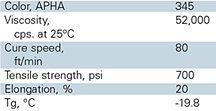
Physical Properties
The properties of both the liquid and cured oligomers were determined during testing. The physical properties of the neat oligomer — glass transition temperature (Tg), tensile strength, and elongation — without any pigment were tested by adding 2% of the photoinitiator, 2-hydroxy-2-methyl-1-phenyl-1-propanone (Ciba: Darocure 1173), and curing the films.The cure speed was at 50 ft/min measured on films prepared and cured on Leneta Chart paper drawdowns using a #1 wire wound rod, and exposed to 2x300-watt/in medium pressure Hg arc lamps of an Ashdee curing unit at various conveyor belt speeds. The cure speeds quoted are the maximum belt speed to obtain a tack-free surface.
To determine the mechanical properties, the liquid formulation was drawn down with a #2 wire wound rod on aluminum panels. The samples were exposed to 2x300-watt/in medium pressure Hg arc lamps of an Ashdee curing unit. The films were then cut and removed from the substrate in order to measure physical properties. An Instron model 5543 was used to measure mechanical properties such as tensile strength and percent elongation at the break point.
Prepared the same as those for mechanical testing, the Tg of the films was measured on a TA Instruments 2010 differential scanning calorimeter. The yellowness index was measured using a BYK 6830 color guide sphere densitometer. Table 1 summarizes these oligomer properties.

Formulations Evaluated
CN-2200 was the base oligomer used in the ink formulations evaluated. Pigment was added at a level of 30% by weight. Following dispersion of the pigment in the oligomer, monomers were added to dilute the pigment to a level of 25% by weight. Table 2 lists the monomers evaluated, which include SR-351, SR-454, SR-492, SR-9020, and SR-494. All of the monomers compared to TMPTA are low skin irritation monomers.SR-351, trimethylolpropane triacrylate (TMPTA), is a low-viscosity, low-volatility liquid monomer, which offers fast cure response and low volatility during free-radical polymerization.
SR-454, 3-mole ethoxylated trimethylolpropane triacrylate, is a low-acid, low-odor, low skin-irritation, fast-curing monomer for use in free radical polymerization. SR-492, 3-mole propoxylated trimethylolpropane triacrylate, is a low skin-irritation, fast-curing monomer for use in free-radical polymerization.
SR-9020, 3-mole propoxylated glyceryl triacrylate, is a trifunctional monomer offering low viscosity, good flexibility, fast curing, and excellent hardness.
SR-494, ethoxylated pentaerythritol tetraacrylate, is a heat-resistant, fast-curing tetrafunctional monomer for use in UV/EB polymerization. It is a low skin-irritation monomer.
Procedure for Pigment Dispersion
The dry pigments were obtained from the following sources: Yellow 14 AAOT (Sun Chemical 274-3744); Lithol Rubine 57:1 (Sun Chemical 219-3707); Phthalocyanine Blue 15:3 (Sun Chemical 249-2083); and Carbon Black (Degussa Special Black 250). Three-roll milling was performed on the dry pigment that was pre-dispersed with gentle agitation to wet out the surface of the pigment particles and agglomerates. Final dispersion of the process colors (Yellow 14 AAOT, Lithol Rubine 57:1, Phthalocyanine Blue 15:3, and Carbon Black) was performed on a Leeson 2.5x5-inch laboratory scale three-roll mill. The dispersions were prepared on a 50-gram scale. The mixtures were passed across the mill 10 times in order to ensure that the same level of grinding had been achieved. Residual pigment agglomerates were visualized using a Hegman grind gauge. All dispersion were scratch-free on the Hegman gauge, indicating there were no pigment particles >1 micron in size.
Rheological Characterization of the Pigment Dispersions
All viscosity measurements were performed on a Brookfield DVIII+ cone and plate rheometer equipped with a CP52 spindle. The rheometer was thermostated at 25ºC for all measurements. The viscosity profile of each dispersion was measured using a simple geometric progression based on shear rate 0.5, 1.0, 1.5, 2.0, 2.5 sec-1, followed by the reverse progression. The data was then analyzed using the Casson equation to quantify plastic viscosity and yield stress. Thixotropic behavior was measured by determining the area of the hystersis loop in the plot of shear rate vs. shear stress.Performance Properties
Viscosity and yield stress measurements were tested for all formulations. In the absence of pigment, all of the acrylate oligomer blends have Newtonian flow, and the viscosity is independent of shear rate. However, the flow changes to a plastic type with the introduction of the pigment. There is a measurable yield stress associated with the pigment dispersion, which is the minimum applied force needed to induce a liquid flow. Ink dispersions show considerable thixotropy, and the viscosity depends on the shearing history of the sample. The plastic flow reflects the packing and chemical interaction of the pigment with the liquid resin, as well as pigment–pigment interactions.
Viscosity
The viscosities of the formulations containing the CN-2200 oligomer, various monomers, and the red, yellow, black or blue pigments were tested. The results obtained at 25°C are shown in Figure 1.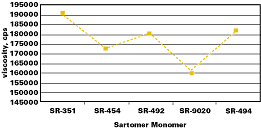
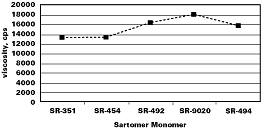
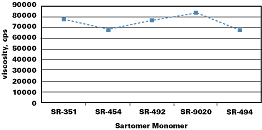
All of the specialty monomers, as well as TMPTA, perform better with the blue pigment.

Yield Stress
The lower yield stress indicates that less energy is required to initiate liquid flow. Yield stress is measured in dynes per centimeter. This parameter is important because it reveals the ability of the ink to flow, allowing it to transfer out of the ink pan. In lithography printing, the ink is fed to the roller train. Alternatively, in flexo printing, the ink is first transferred to the anilox. Poor flowing inks in either case are not effectively transferred to the substrate, ultimately resulting in low color density prints with low gloss.Yield stress of the pigmented formulations is shown in Figure 5.
Results of CN-2200 with the rubine pigment reveal that all the monomers tested perform as well as or better than the SR-351. SR-454 and SR-492, the ethoxylated and propoxylated TMPTA monomers, perform particularly well.
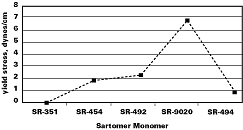
Figure 7 shows the yield stress of the SR-351 in CN-2000 with the black pigment fares the best and mirrors the viscosity curve.
As with the viscosity curves, the CN-2200 and all of the monomers perform similarly with the blue pigment.
Conclusion
Low skin-irritation monomers offer the same performance in various colors of ink as the TMPTA monomer, SR-351. The low skin irritation monomers, SR-454, SR-492, SR-9020, and SR-494 perform well with the polyester acrylate oligomer, CN-2200. This oligomer offers improved pigment wetting, leading to enhanced flow properties of dispersions. This feature of the oligomers can be used to formulate inks with rheology better suited for the particular printing process, or to prepare inks with higher pigmentation levels.The polyester acrylate CN-2200 gives pigment dispersions that offer excellent flow, low viscosity, and low thixotropy. The cured films of this oligomer yield slower-curing, soft, flexible films.
For more information on oligomers, contact Sartomer Co., Oaklands Corporate Center, 502 Thomas Jones Way, Exton, PA 19341; phone 610/363.4199; fax 610/594.0252; e-mail burak@sartomer.com; visit www.sartomer.com.

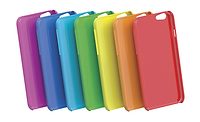
Report Abusive Comment